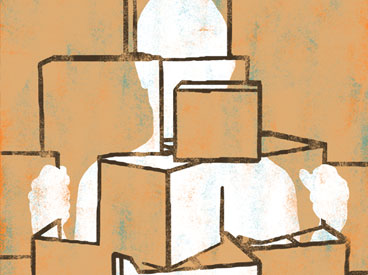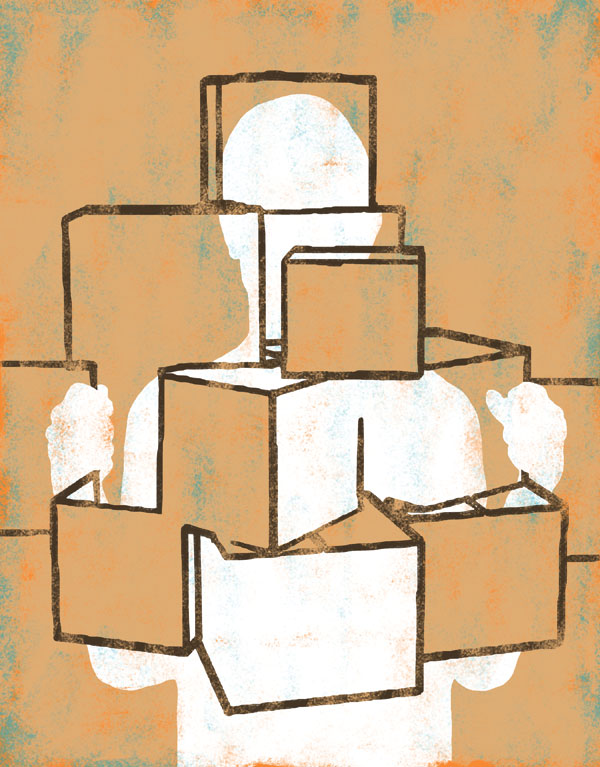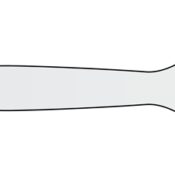Some people wear their emotions on their sleeve. Others manifest it in the nest: The state of their homes reflects their state of mind. When depression sets in, the clutter can pile up.
Charles Miles can relate. He owns a three-bedroom Colonial-style home in Bogota, New Jersey, but when he’s feeling blue, routine maintenance is hard to keep up. “There are dishes in the sink. Newspapers on the floor. Instead of putting things away, I leave them where they are. I think, ‘What’s the point?’ I’m just not motivated. It’s the demon I fight all the time.”
Healthcare professionals know all too well the connection between clutter and depression. The abilities you need to keep a home clean and in relative order go by the wayside with depression. People who lose their drive find it hard to handle basic housekeeping and organizational tasks. “A systematic pattern of home neglect is really a form of self-neglect,” says Dr. Holly Parker, a practicing psychologist and faculty member of Harvard University. “People with depression often have low energy, almost like taking gas out of the tank of a car. They lose the motivation to do things they used to love to do. If they give up hobbies, they definitely won’t do housework.”
Clutter is difficult to contain under the best of circumstances. Every Felix Unger has a bit of Oscar Madison in him. For most, it’s a matter of having too much stuff and not enough places to store it. Some have called it an epidemic of affluenza. As a nation of affluence, we buy without thinking what we’re going to do with it, how we’re going to use it, and where we’re going to put it. And because we’re busier than ever, we have less time to figure it all out.
The fact is that previous generations simply didn’t have all the stuff we have today. They were never tempted by 24-hour shopping channels, blasted with emails about last-chance sales, or bombarded with catalogs and junk mail. Generations from baby boomers to millennials may have it all within reach, but most haven’t learned how to keep it in balance. Homes continue to grow fuller, despite our households growing smaller.
It’s not the whole problem, though. Clutter isn’t just about bringing new stuff into the home but the inability to purge the old. Some adhere to the waste not, want not school of housekeeping. Obsolete electronics? Clothes that haven’t fit in years? Broken tools? Folks with a Depression-era mindset hate to throw anything away. And then there are the objects with sentimental value, the biggest clutter culprits because they’re the hardest to part with of all. It’s little wonder why in the U.S. alone, the self-storage industry is a $22 billion business annually.
Living in clutter is more than just a matter of aesthetics. Clutter is an energy sapper that takes its emotional toll and steals domestic joy. If home is where the heap is, it’s a good bet family members are more stressed and less productive. It can create tension in personal relationships. It can cause people to be chronically behind schedule because they can’t find their car keys or they’re unable to sift through their closets for a complete outfit in the morning. And children can suffer as well. Some youngsters experience problems at school because they’re routinely late for class or under prepared for assignments.
Clutter comes in degrees, from mild to severe, from annoying to debilitating. While it can cause anxiety and depression, it can conversely be a symptom of a problem. Professional organizer MaryJo Monroe, owner of reSPACEd, a residential organization and design firm in Portland, Oregon, says one of the first things she notices working with a client who might be depressed is low energy output. “They don’t have stamina. Instead of working two to four hours at a stretch, they’ll start to poop out after an hour.” Another red flag is difficulty making decisions. When the ability to concentrate wanes, figuring out whether to keep, toss, or relocate things becomes impossible.

Self-esteem issues can be at the root. The attitude? I’m just not worth the effort. And it spirals downward from there. When it becomes hard to muster the motivation to turn things around, it can create a negative cycle that feeds on itself. People often become more stressed and more depressed because of the mess. And the inability to dig oneself out brings on feelings of hopelessness.
Losing his job of 14 years started a downward spiral for “John” who was living outside Seattle, Washington. He defaulted on his mortgage and lost his home. The stress caused the dissolution of his marriage and alcohol took over his life. “I started letting things go. Dishes piled up in the sink, garbage was almost never taken out. After all, what was the use? I knew I could pull myself out of it. But not today. Today I didn’t feel like it. I felt like sleeping.” Through the help of a friend, John went into a detox program and got help for his depression. He moved to a new state, got a new job and apartment. “As for how I feel when I come home, the difference is amazing. Coming home to a neat place, and knowing that everything in it—including the cleanliness—was earned by me, makes everything I do there, from waking up in the morning to watching the Late Show before I go to bed, that much sweeter.”
And that message of hope is exactly the one professionals strive to communicate.
Spring is an ideal time to start getting clutter under control. For many, seasons can have a powerful affect on their moods. In the spring, the days are longer, flowers start blooming, people are out and about. Those who struggle during the short, dark days of winter perk up in the spring. “It’s an uplifting time,” Parker says. “You can capitalize on that time of year by getting more things done and capitalize on that boost of mood that comes with longer days.”
Solving clutter problems is a two-step process that takes planning. The first part is getting to the root of the problem, and a number of treatments can help such as therapy, medication, and doing regular exercise.
The second part is putting a system in place. (See “Seven Steps to Clutter Control.”) Enlisting a friend or family member in the organizational process can give the chronically disorganized the cheerleading morale they need to keep going. A home that looks good helps us feel good. And New Jersey homeowner Charles Miles can relate to that, too. When his outlook brightens, tackling the clutter is job number one. His reward for a home organizational makeover is a sense of accomplishment and renewed self-confidence. “I feel great,” says Miles. “I’m like, ‘Let’s invite the neighbors over for dinner!’”
Illustration by Gwenda Kaczor.
Become a Saturday Evening Post member and enjoy unlimited access. Subscribe now




